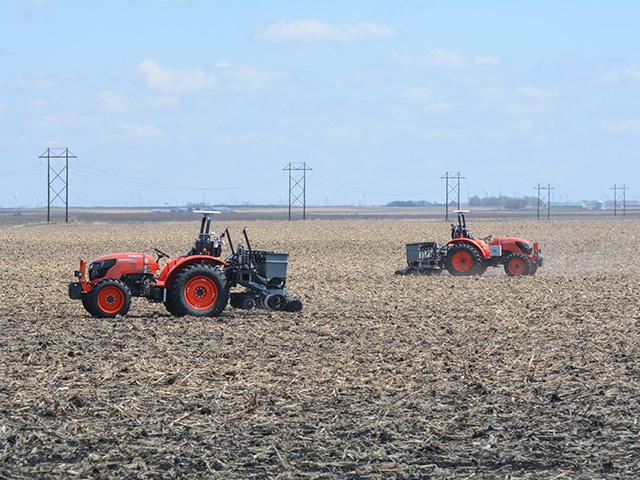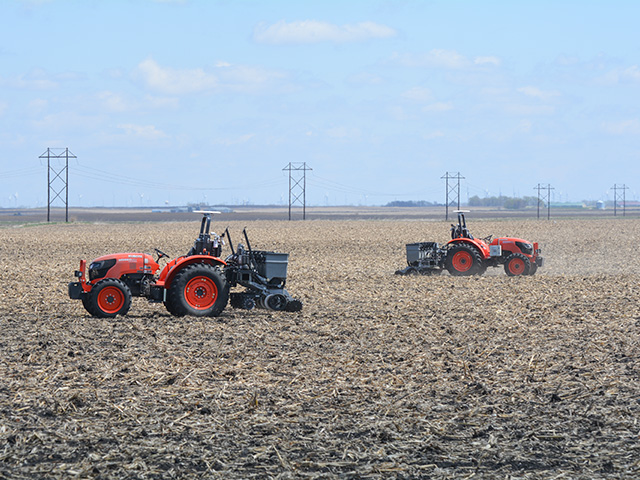MachineryLink
Sabanto Knocks Down Autonomous Roadblocks
Sabanto Inc. was named winner earlier this week in the 19th annual Chicago Innovation Awards program. The award cites Sabanto's work as a cutting-edge Farming-as-a-Service company performing row-crop field operations using small, cost-effective, autonomous machines.
Sabanto has been making headlines with its deployment of autonomous tractors throughout the Midwest over the last couple of years. (See https://www.dtnpf.com/…, https://www.dtnpf.com/… and https://www.dtnpf.com/…)
We caught up with Sabanto CEO Craig Rupp this week and talked about the splash the company is making in the world of autonomous farming. Rupp and a team of seven technicians have been this year collecting data, planting and cultivating thousands of acres in Iowa, Nebraska, Minnesota and Illinois.
"We are working with farmers as an extension of their capabilities," Rupp said. That means the direction of Sabanto's work would eventually produce autonomous machines that at first could do perhaps less-intensive work on the farm -- for example, tillage behind a combine as it harvests a crop. Twenty-four-hour autonomous operations will eventually allow managers to move human resources to more task-intensive work, Rupp explained. That will give owner/managers greater ability to squeeze more efficiency and productivity out of their operations.
Rupp declined to reveal how many acres his autonomous units have covered. But he did allow that some operations have gone close to 40 uninterrupted hours. Sabanto deploys Kubota's 60 hp M5660s and 90 hp M5s in its work (easily transportable). Rupp said the machines have also performed operations overnight, work monitored from a distance, but without human intervention in the field. One cultivating unit completed an entire field without human intervention.
Rupp remembered how, in 2019, Sabanto's first year, they came out of fields "bloodied" from the continual hurdles they encountered. "But we kept chipping away (at the problems). Every acre we cover, we get better," Rupp said. "Our software and path planning just gets better. We are fixing problems in the field, not just writing software in cubicles."
The result? "Well, we didn't come from planting this year with our tails between our legs. But there were places we could have done better," Rupp said.
There are dozens of actions to be addressed. Communications. Navigation. How does the bounce of a tractor affect performance? Fuel use and fuel optimization is a newer course of inquiry. How an autonomous machine interacts with a seed tender is another.
"Autonomy is not going to be all or nothing," Rupp said. "Autonomous tillage make sense (today). An autonomous harvest is going to be harder. Adoption isn't going to be overnight, and adoption will be more on the local farm level."
P[L1] D[0x0] M[300x250] OOP[F] ADUNIT[] T[]
Earlier this year, DTN/Progressive Farmer collected questions from readers about autonomous farming operations. Below, is a Q&A DTN/Progressive Farmer held with Rupp some months back. In that, he answered reader questions about his work. Responses were slightly edited for clarity.
**
Q: How will autonomous tractors and planters be filled with fuel, seed and maintained while working?
A: Right now, at least one person needs to be on-site to tender equipment and one person off-site to monitor it. Obviously, replenishing supplies will be done autonomously.
Q: How many people will it take to monitor, operate and keep each planting unit or units moving per location?
A: We're working to reduce that number by as much as we possibly can. Right now, there are several people on- and off-site to keep them going. Our goal is to continue to automate the process where one person brings the equipment and supplies to a site and one person monitors it.
Q: How will a driverless tractor avoid obstacles in a field such as unmapped tile inlets, guide wires, sink holes, rocks, mud, etc.?
A: We do have sensors, cameras and technology onboard to avoid obstacles. The tractor will stop. We haven't ran into issues yet because of our safety systems. The remote operator can get a visual of what's going on to avoid and possibly maneuver the unit around the problem area. We've had to take GPS coordinates for two new tile inlets in one field and build that into the plan. Meanwhile, I see a lot of tweets where a farmer in a tractor completely buries it or hit objects.
Q: How does the equipment judge if it's too muddy to plant an area, and who makes the call to plant depending on field conditions?
A: Our equipment is much lighter than most (about 7,000 pounds for a tractor and planter), so that will play a part in it. We just won't drop off equipment and run. There will be a level of scouting to see if there are issues in the field. Can it be planted? Can other areas be planted first or not at all? The company will make that decision.
Q: If a planter hits a rock and something breaks or malfunctions, what will the autonomous unit do?
A: We're highly instrumented to detect that. Every field is a learning experience. There are sensors to mitigate that problem. The planters are fully monitored to detect problems.
Q: Can the autonomous units plant an entire field on its own, including head lands and end rows and navigate waterways?
A: We're semi-autonomous with end rows and head lands now. It will be done eventually. Waterways will be factored in the path plan.
Q: How will equipment be moved from field to field?
A: Someone can jump in the seat and drive from field to field. We put the tractors and planters on a flatbed trailer that a pickup pulls. Last year, the 235-horsepower tractor and 18-row planter was hauled by a semi.
Dan Miller can be reached at dan.miller@dtn.com
Follow him on Twitter @DMillerPF
Matthew Wilde can be reached at matt.wilde@dtn.com
Follow him on Twitter @progressivwilde
(c) Copyright 2020 DTN, LLC. All rights reserved.






Comments
To comment, please Log In or Join our Community .